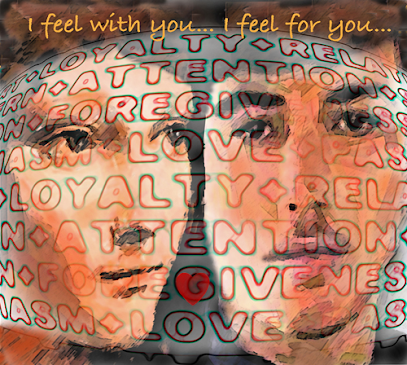FEEL PHILOSOPHY
Empathy and sympathy, though habitually conflated in colloquial usage, are in fact conceptually discrete, each rooted in fundamentally divergent affective architectures predicated upon the notion of affections. Affections, as opposed to passions, are volitional, immaterial mental states-deliberate cognitive-emotional phenomena such as enthusiasm, resentment, or forgiveness-that serve as the substrate for both empathy and sympathy.
Passions, by contrast, are involuntary, corporeal responses-manifestations of the body’s reflexive engagement with stimuli, such as the pain experienced upon contact with a hot surface. These passions are unbidden and somatically anchored, whereas affections are consciously willed, persisting as attitudes or dispositions within the mental domain.
This bifurcation between passions and affections is pivotal: empathy and sympathy are not reflexive passions but rather voluntary acts of affective attunement. Empathy is best construed as the cognitive-affective assimilation of another’s affections-a resonance with the volitional emotional states of another, always approximate and never a perfect facsimile. Sympathy, on the other hand, is the deliberate adoption of supportive affections-loyalty, favor, or solidarity-toward another, which may or may not be predicated upon empathetic understanding.
Illustrative cases elucidate this distinction: relinquishing resentment to enact forgiveness is a paradigmatic act of volitional affection, as is the cultivation of diligent attention, which is facilitated by affective preference and not mere somatic drive. Empathy enables nuanced social navigation, potentially even instrumental manipulation, by allowing one to approximate another’s affective state. Sympathy, in contrast, is the affective impetus for supportive or benevolent action, the practical outworking of affective alignment.
Ethically, both empathy and sympathy are subject to selective deployment, contingent upon relational proximity, moral obligation, or pragmatic calculus. Empathy does not inexorably beget sympathy; one may apprehend another’s affective state without being moved to supportive action. Moreover, empathy cannot extend to involuntary physical pain (a passion), but only to the concomitant affections-such as concern or anxiety-that accompany such pain.
Thus, empathy and sympathy are not mere emotional reflexes but sophisticated, cognitively mediated affections, consciously chosen and distinct from the involuntary realm of passions. Their interplay and divergence structure the architecture of human relationality, shaping the contours of our ethical and emotional engagements.
WORDS TO BE NOTED-
Substrate
A base or underlying layer; here, the foundation for something.Corporeal
Relating to the body; physical.Manifestations
Clear signs or displays of something.Somatically anchored
Rooted in the body or physical sensations.Volitional
Related to the act of making a conscious choice or decision; done by wilL.
SOURCE- PHILISOPHY NOW
FLESCH-KINCAID LEVEL -16
PARA SUMMARY-Empathy and sympathy, though often confused, are fundamentally distinct emotional mechanisms rooted in the concept of affections-voluntary, mental states such as love or resentment. Unlike passions, which are involuntary and physically anchored (like pain or anger), affections are consciously chosen and persist as attitudes or dispositions. Empathy involves cognitively and emotionally approximating another’s affections, allowing one to understand and resonate with their feelings, while sympathy is the deliberate adoption of supportive attitudes such as loyalty or favor toward another. Both are voluntary and can be selectively applied based on relationships or ethical considerations, but empathy does not always lead to sympathy or supportive action. Importantly, empathy cannot extend to another’s physical pain (a passion), but only to the mental affections accompanying it. Thus, empathy and sympathy are sophisticated, cognitively mediated responses that shape our ethical and emotional interactions with others



Comments
Post a Comment